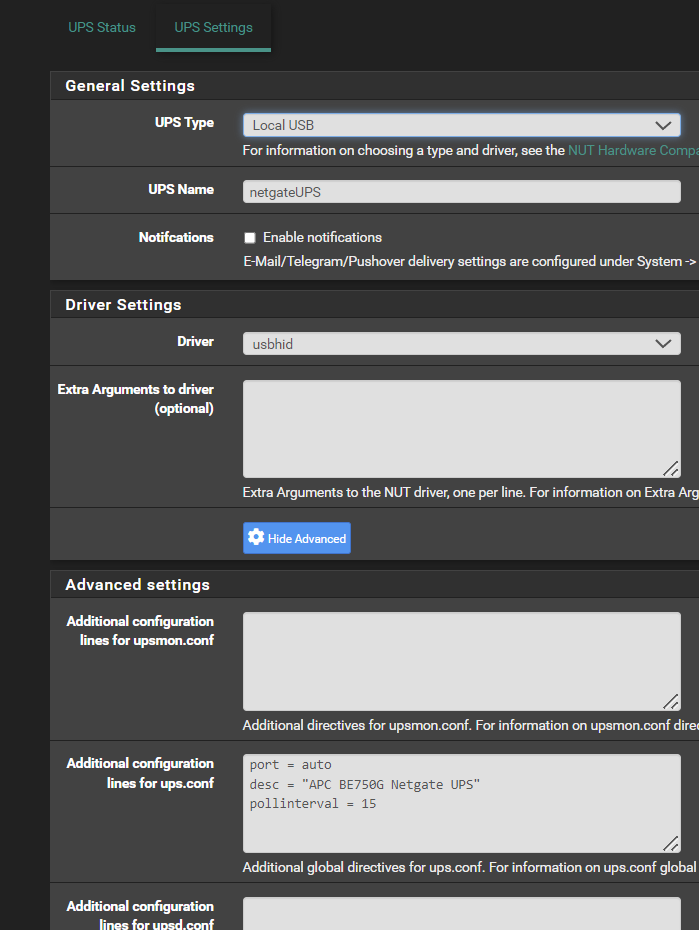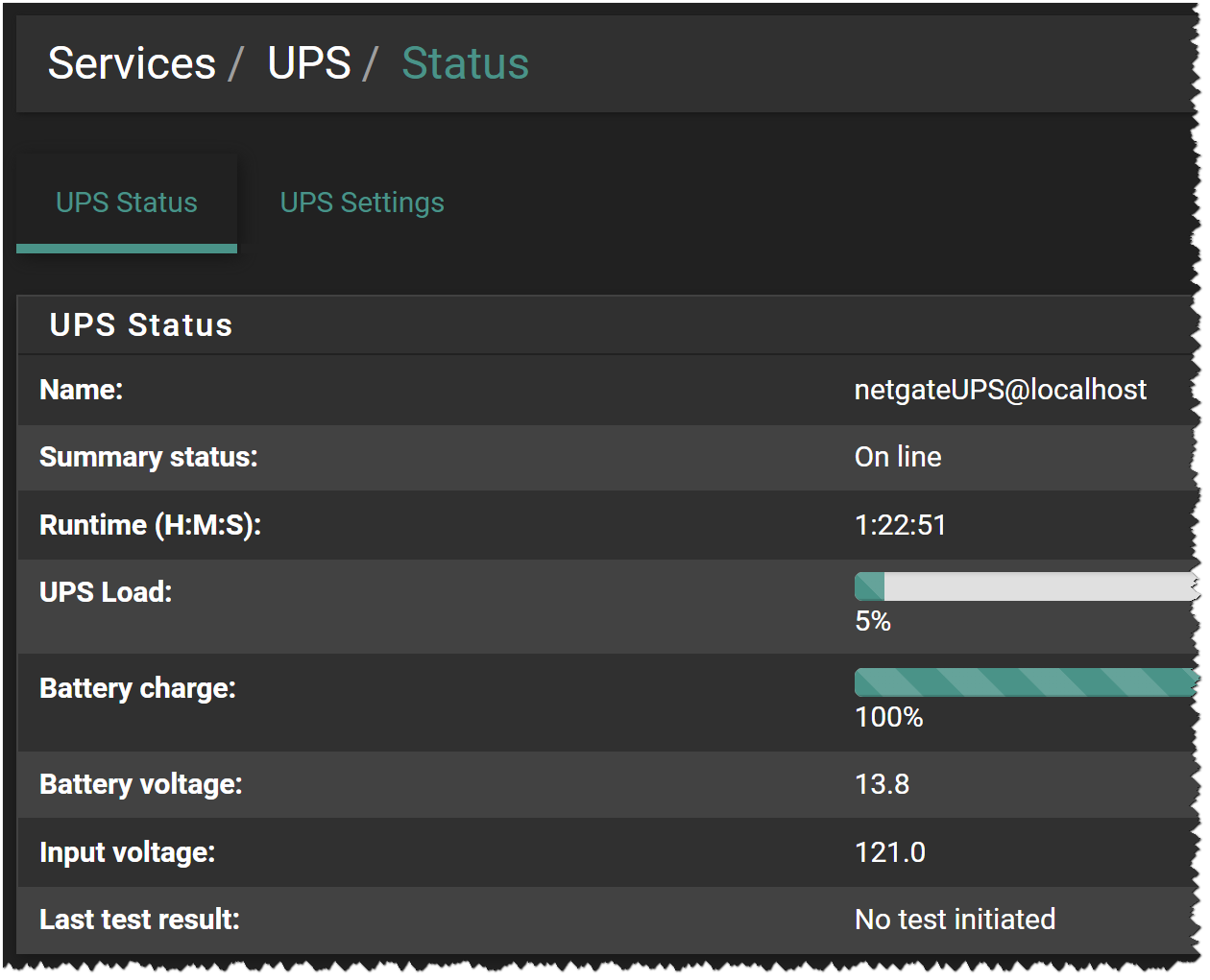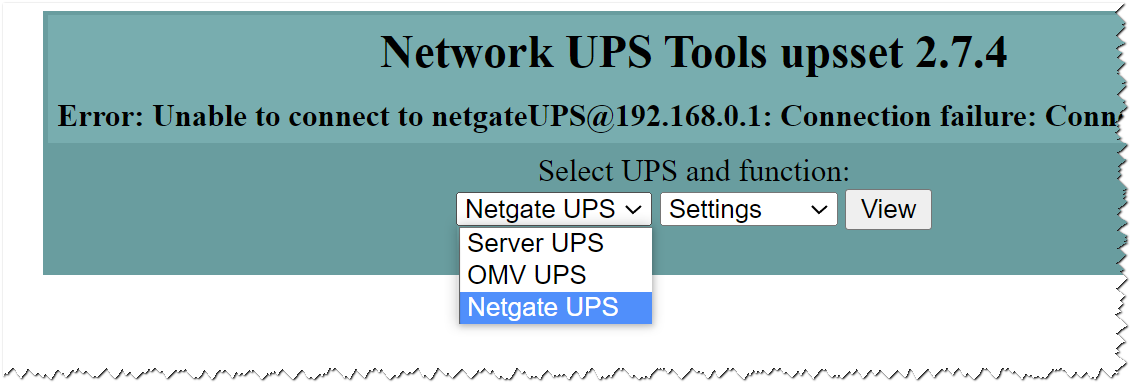NUT server and UPS general question
-
@dennypage @dennypage said in NUT server and UPS general question:
UPS 3: Pick a system to be the Primary and run a standard NUT Primary install on that system. Run NUT Secondary on the other systems using remote NUT to the Primary.
Let me parse your reply

In my case 3 servers....Pick one server as PRIMARY say server 1 and install standard NUT on server 1. Install NUT secondary on server 2 and server 3. Run Remote NUT to the primary. I am going NUTS. In other words this UPS 3 is stand alone "farm" no connection to NUT installed in raspberry PI.UPS 1: Attach the UPS to some system and run NUT as monitor only (use 0 as the power value for upsmon).
UPS 2: Run standard NUT Primary on the Pi.For above 2 scenario's Rasberry PI is to be used. The configuration for NUT in PI for UPS 1 is monitor only and UPS 2 is standard NUT as primary
Have I understood it marginally?
-
@netboy dennypage, I did some reading......
The UPS 3 has 3 servers and one of them is Openmediavault (OMV) and 2 of them or ubuntu.It so happens, OMV has a NUT package and I installed it after making sure my UPS is connected to OMV using USB (checked lsusb to make sure the UPS shows up). The package worked as standalone.
The package has another option called REMOTE MONITORING (Enable remote monitoring of the local connected UPS.) which I believe is a server mode (or PRIMARY in your speak as I understand).
So here is what I think are my next steps:-
Enable server mode in OMV (with some username/pswd)
-
Install NUT client in server 2 and 3 (ubuntu) and point them to OMV using username/pswd (SECONDARY in your speak)
And finagle it to work.
Have I got it right so far?
-
-
@netboy said in NUT server and UPS general question:
In my case 3 servers....Pick one server as PRIMARY say server 1 and install standard NUT on server 1. Install NUT secondary on server 2 and server 3. Run Remote NUT to the primary. I am going NUTS. In other words this UPS 3 is stand alone "farm" no connection to NUT installed in raspberry PI.
Server 1 would be the NUT Primary (NUT's new term--previously called master), and would perform the actual control of the UPS. Server 2 & 3 would be Secondaries (previously called slaves), and take their instruction from the Primary. When the Primary says "time to shut down" the Secondaries shut down and disconnect from the Primary, after which the Primary shuts down which kills UPS power.
Note that you can still "monitor" the the Server 1 UPS using NUT on another host (Pi). You would configure it as a Secondary, but use a power value of 0 to indicated that you are not actually connected to the UPS on Server 1. You can use this approach to monitor all the other UPSs from the Pi as well.
-
@netboy said in NUT server and UPS general question:
It so happens, OMV has a NUT package and I installed it after making sure my UPS is connected to OMV using USB (checked lsusb to make sure the UPS shows up).
Just about everyone has a NUT package. It's pretty universal.
Have I got it right so far?
I believe so.
-
@dennypage Thank you.... shall read more and figure it out
-
This post is deleted! -
@dennypage said in NUT server and UPS general question:
Server 1 would be the NUT Primary (NUT's new term--previously called master), and would perform the actual control of the UPS. Server 2 & 3 would be Secondaries (previously called slaves), and take their instruction from the Primary. When the Primary says "time to shut down" the Secondaries shut down and disconnect from the Primary, after which the Primary shuts down which kills UPS power.
Note that you can still "monitor" the the Server 1 UPS using NUT on another host (Pi). You would configure it as a Secondary, but use a power value of 0 to indicated that you are not actually connected to the UPS on Server 1. You can use this approach to monitor all the other UPSs from the Pi as well.Very useful info....thanks
-
@netboy dennypage I got everything working....
Now based on my success I would like to monitor the UPS attached to the Netgate router.
I earlier installed apc package and it worked fine. I uninstalled the same and installed NUT.
SSH into netgate and it reported the UPS.
[22.05-RELEASE][admin@router2100.xxx.local]/root: usbconfig
ugen0.1: <Marvell XHCI root HUB> at usbus0, cfg=0 md=HOST spd=SUPER (5.0Gbps) pwr=SAVE (0mA)
ugen1.1: <Marvell EHCI root HUB> at usbus1, cfg=0 md=HOST spd=HIGH (480Mbps) pwr=SAVE (0mA)
ugen1.2: <American Power Conversion Back-UPS ES 750G FW:841.I4 .D USB FW:I4> at usbus1, cfg=0 md=HOST spd=LOW (1.5Mbps) pwr=ON (2mA)My config on the NUT in netgate is as follows:

However I am not having any success!!

Any tips for troubleshooting?
After some time in SSH I get this message:
 Broadcast Message from root@router2100.480.local
Broadcast Message from root@router2100.480.local
(no tty) at 12:41 EST...UPS netgateUPS is unavailable
-
@netboy said in NUT server and UPS general question:
Any tips for troubleshooting?
Yes:
-
Remove everything from the Advanced settings section and leave it empty. [FYI: The lines you have are in the wrong section; The USB driver doesn't take a port. Some UPSs don't like to be polled too frequently.] Later, you can add lines to the "Additional configuration lines for upsd.users" section to allow remote access, but even then leave all the other sections empty.
-
If you haven't rebooted since you installed NUT, you need to do so. Alternatively, you can do an unplug and replug (see elsewhere in this thread), but the easiest thing to do is to reboot.
-
-
@dennypage Thanks
Followed your advice and it works now ....

I added users to the upsd.users and "pointed" the hosts.conf and upsmon.conf on the raspberry pi.
The raspberry pi shows the drop down but when I select the one nothing shows up! Other drop down works like a charm.
Any other config I must change in netgate?
The selection of "netgate UPS" does nothing and shows connection failure
-
@netboy said in NUT server and UPS general question:
The selection of "netgate UPS" does nothing and shows connection failure
I note that in one location you have "netgateUPS" and in another you have "netgate UPS". FWIW, I recommend that you stay away from spaces in names.
-
@dennypage Hey dennypage the drop down shows the description as listed in Raspberry Pi hosts.conf
MONITOR netgateUPS@192.168.0.1 "Netgate UPS"
IMHO, I do not think this is the issue.
FYI, i have added the following user in netgate config:
[monslave]
password = {somepassword}
upsmon slaveAdded the following in upsmon.conf in raspberry pi;
MONITOR netgateUPS@192.168.0.1 0 monslave {pswd for monslave} slave
-
@netboy Please post your upsd.users and upsmon.conf from both systems.
-
@dennypage
Sure here we go...Masked password as xxxx, yyyy and zzzz - BTW there are no spaces in my password:
netgate - upsd.users
[admin]
password = xxxxx
actions = set
actions = fsd
instcmds = ALL[monmaster]
password = yyyyy
upsmon master[monslave]
password = zzzzz
upsmon slavepi- upsd.users
[admin]
password = nnnnnn
actions = set
actions = fsd
instcmds = ALL[monmaster]
password = uuuuuuu
upsmon master[monslave]
password = xxxxx
upsmon slavenetgate - upsmon.conf
blanks no entriespi - upsmon.conf
MONITOR netgateUPS@192.168.0.1 0 monslave zzzzz slaveAm I missing MONITOR entries in upsmon.conf in netgate?
-
@netboy said in NUT server and UPS general question:
netgate - upsmon.conf
blanks no entriesBased upon your prior screenshots, upsmon.conf on the pfSense system cannot be empty.
Also, please post ups.conf from both systems.
-
@dennypage
I added the following tonetgate - upsmon.conf
MONITOR netgateUPS@localhost 1 monmaster yyyyy masternegate - ups.conf
blanks no entriespi- ups.conf
[powerStrip]
driver = usbhid-ups
port = auto
vendorid = "051d"
productid = "0002"
desc = "APC BE600M1 600VA UPS" -
@netboy said in NUT server and UPS general question:
I added the following to
netgate - upsmon.conf
MONITOR netgateUPS@localhost 1 monmaster yyyyy master
negate - ups.conf
blanks no entriesSomething is wrong. ups.conf cannot be empty, and you should not need to edit upsmon.conf.
Let's restart from the ground up and make sure we have a known, stable base.
Go to Services -> UPS -> Settings.
- Set "UPS Type" to "Local USB"
- Set "UPS Name" to "ups"
- Uncheck the "Enable notifications" box
- Set "Driver" to "usbhid".
- Clear any content in "Extra Arguments to driver"
- Clear any content in all sections of "Advanced sections"
After doing this, press save.
Then, log in via terminal and execute the following:
cat /usr/local/etc/nut/ups.conf cat /usr/local/etc/nut/upsd.conf cat /usr/local/etc/nut/upsd.users cat /usr/local/etc/nut/upsmon.confAnd post the complete output of each.
-
@dennypage
masked passwords[22.05-RELEASE][admin@router2100.tttt.local]/root: cat /usr/local/etc/nut/ups.conf
[ups]
driver=usbhid-ups
port=auto
[22.05-RELEASE][admin@router2100.tttt.local]/root: cat /usr/local/etc/nut/upsd.conf
LISTEN 127.0.0.1
LISTEN ::1
[22.05-RELEASE][admin@router2100.tttt.local]/root: cat /usr/local/etc/nut/upsd.users
[admin]
password=xxxxx
actions=set
instcmds=all
[local-monitor]
password=xxxxx
upsmon master
[22.05-RELEASE][admin@router2100.tttt.local]/root: cat /usr/local/etc/nut/upsmon.conf
MONITOR ups 1 local-monitor xxxxx master
SHUTDOWNCMD "/sbin/shutdown -p +0"
POWERDOWNFLAG /etc/killpower
[22.05-RELEASE][admin@router2100.tttt.local]/root: -
@netboy Okay, that looks much better.
Now add this
[monuser] password = secret upsmon slaveto "Additional configuration lines for upsd.users" in the Advanced settings section.
Now go to this post and follow the instructions to allow access to the NUT port from the LAN interface. I recommend that you choose option 1.
Following that, you can confirm operation by going to the pi and executing the following command:
upsc ups@192.168.0.1
[Based on prior posts, I am assuming that 192.168.0.1 is the LAN IP address of your pfSense firewall]When you run the upsc command, you should see all the variables of your UPS displayed.
Lastly, for the pi end, put this in upsmon.conf:
MONITOR ups@192.168.0.1 0 monuser secret slave -
@dennypage I guess the MONITOR must be like below (see bold) - correct - Probably you have a typo?
MONITOR ups@192.168.0.1 0 monuser secret slave